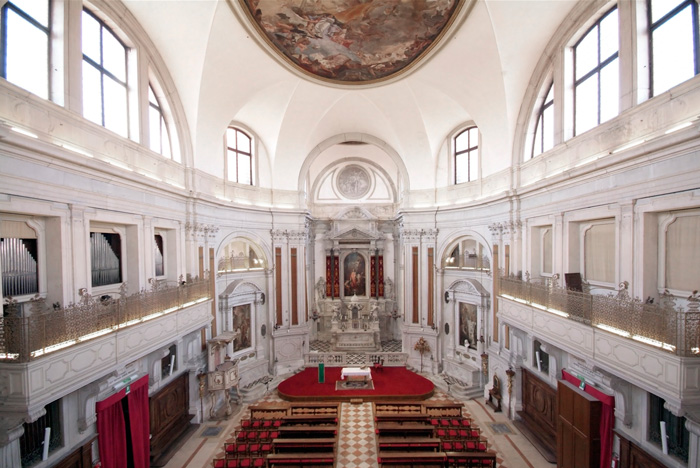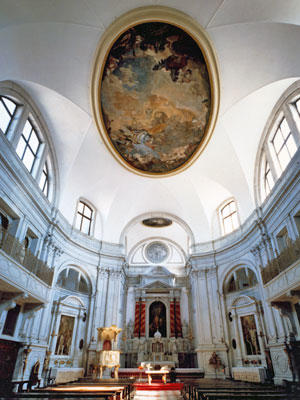The Church and the Hospital of Pity: a bit of history

The imposing size of the Church of Pity rises like a Greek temple from the sophisticated Riva degli Schiavoni.
Its history is closely linked to that of the charitable institution of the Hospital of Pity, founded in 1346 with an official decree promulgated by the Senate of the Republic of Venice, thanks to the charitable works of the Franciscan friar Petruccio d'Assisi, one of the major patrons. The institute was born to welcome abandoned children and needy creatures: since then the Serenissima supported the foundation with great interest. Thus the Hospital became the most important orphanage in the city of Venice, and was responsible for the training and education of young orphans, also with the teaching of music: great masters followed one another in the direction, including the composer Antonio Vivaldi, in chair since 1703.
The Governors of the charitable institution promoted the construction of the present church in the mid-eighteenth century, replacing the previous building. The work was entrusted to the Venetian architect Giorgio Massari, a skilled interpreter of the teachings of Palladio and Longhena. The sanctuary was consecrated in 1760, but work continued until the early twentieth century, albeit with some modifications compared to the original project.
Today the foundation is still active with the name of Provincial Institute for the Infancy Saint Mary of Pity.
Art and beauty in the Church of the Pity

The structure of the Church is of a clear classic style: tall the columns that rise on a high base and divide the space of the façade into three sections and act as support for the crowning triangle tympanum. The entrance portal also depicts the lines of a small temple and shows the design of the facade in reduced dimensions: above this, a magnificent bas-relief depicts the Virgin in the act of charitably welcoming the orphans.
Before crossing the front door it is interesting to observe a plaque set into the plinth of the second column starting from the left. This is a memorial, dated November 12th 1548, which warns the wealthy families who abandon their children to follow the prescriptions given in this regard by Pope Paul III Farnese: these will be punished, as the Pontiff himself had declared, by the implacable divine wrath in the case of this ignoble act. An interesting cross-section of social history that is connected to what was said previously about the beneficent work of the Pietà and that prepares us for entering the church.
Crossing the threshold to surprise us is the plan of the building: an ovoid plant that gives harmony and elegance, born with the aim of optimizing the spread of music. The interior space is marked and embraced by the choirs with iron gratings that run along the side walls: this is where the so-called Daughters of Choro used to perform, the students of the musical conservatory, who were led to bel canto by masters such as Antonio Vivaldi and Francesco Gasparini. The Putte del Choro, as well as the young musicians were called, were the spearhead of the church and the institute and attracted an international audience with their skill.
But the church also offers grounds for aesthetic satisfaction, and not only historical. In fact, if you look up as soon as you enter, a fresco by Giambattista Tiepolo: "The Fortress and Peace" will welcome you. The great Venetian artist is the author of two other frescoes: "The Virtues of Theology" which decorate the ceiling of the tribune and the "Triumph of Faith", made for the ceiling of the choir.
The Church of the Pietà is linked to the name of another famous artist, Giambattista Piazzetta who made the beautiful altarpiece with "La Visitazione": unfortunately the painter, who died in 1754, could not complete the painting that was finished by Giuseppe Angeli, his disciple. The altarpiece is the background to the beautiful tabernacle embellished with gilded bronze figures made by an exceptional team: The Archangels Gabriel and Michael are attributed to Giovanni Maria Morlaiter; the San Marco to Antonio Gai while the San Pietro was built by Giovanni Marchiori.
The Church of Pity, with an adjoining hospital, is not just a place to retrace important pages of Venetian history. But also an artistic shrine, where you can admire the work of the most famous masters of the Venetian eighteenth century. A place, however, where it will also be possible to visit an interesting museum of musical instruments of the time: a small space set up in 2004 that brings together a collection of baroque instruments, for music lovers.
The complex can be visited from Tuesday to Sunday from 10:00 to 18:00 at a cost of € 3.00.










Lascia un commento